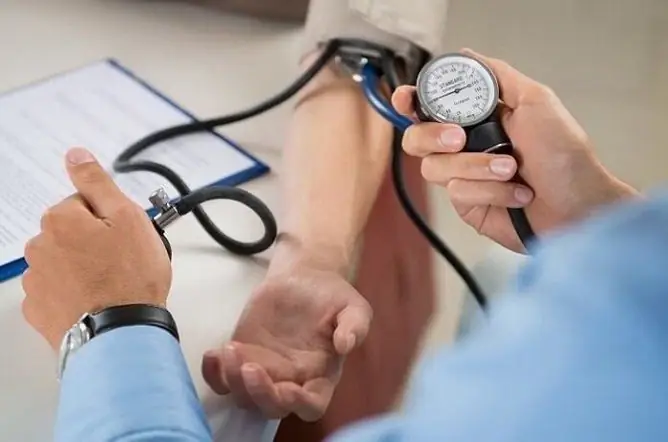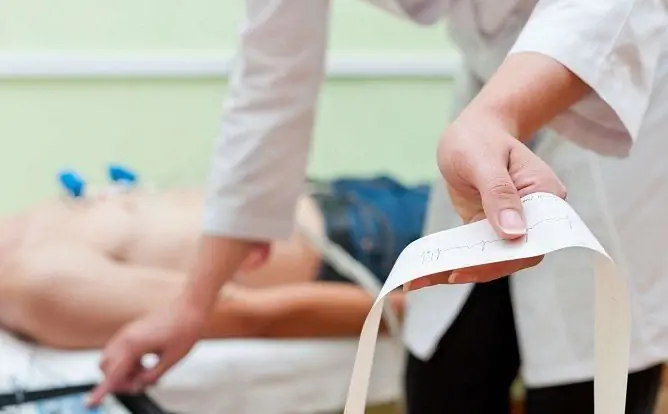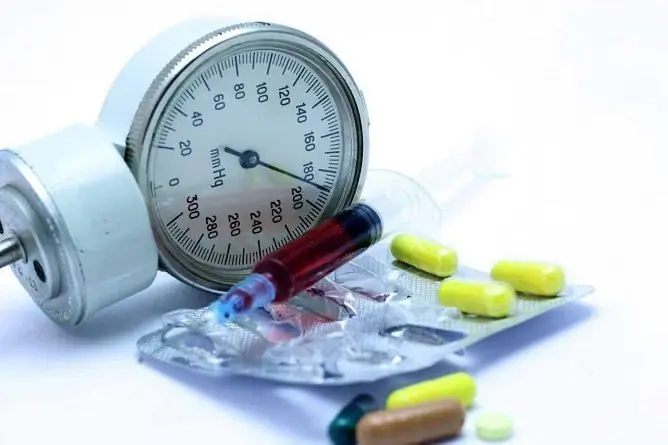- Author Rachel Wainwright [email protected].
- Public 2023-12-15 07:39.
- Last modified 2025-11-02 20:14.
Low (weak) pulse at normal pressure
The content of the article:
- The mechanism of occurrence of a rare pulse
- What causes a weak pulse at normal pressure
- What is the manifestation of a reduced pulse at normal pressure under normal conditions
- Rare pulse at normal pressure: what to do?
- Video
A low pulse at normal pressure occurs in perfectly healthy people, but it can also be a sign of pathology.
In this case, they speak of bradycardia, which is diagnosed when the frequency of contractions of the heart muscle decreases to numbers not exceeding 55-59 beats per minute. Nevertheless, there are people for whom the heart rate (HR) even at 45-50 beats / min is the norm, so only a specialist can judge whether a slowdown in the heart rate in a particular case is bradycardia.

Low pulse rate while maintaining normal blood pressure levels is often noted in athletes
The mechanism of occurrence of a rare pulse
Normally, the myocardium (the muscular layer of the heart) has, among others, such important characteristics as excitability, contractility and automatism.
Automatism is the ability of certain anatomical structures in the thickness of the myocardium to independently (without the participation of the central nervous system) form a nerve impulse.
Excitability provides the possibility of the propagation of nerve impulses from the pacemaker of the first order (sinus node, where it originates) in all parts of the heart with their consistent uniform excitation.
Contractility is the ability of the heart chambers under the influence of incoming nerve impulses to work rhythmically according to a certain algorithm.
Due to the combination of these factors, the heart contracts with a certain frequency and strength.
The signal about the contraction of the muscle cells of the heart is formed in the sinus node located in the right atrium. From there, impulses arrive at the nodes of a lower order and, as a result, propagate along special nerve fibers through the tissues of the ventricles.
Normally, nerve impulses are formed at a frequency that provides 60-80 heart beats per minute. In this case, there is a coordinated contraction of the left and right atria, ventricles and their subsequent relaxation - this chain of coordinated actions is called the cardiac cycle.
In some cases, there is a violation of the formation and propagation of impulses in the tissues of the heart:
- damage to the pacemaker and underlying nodes;
- decreased functional activity of the sinus node;
- violation of the propagation of the signal from the pacemaker along the legs and fibers of the conducting system.
When the heart rate drops, the pulse may remain rhythmic or falter. This condition is referred to as bradycardia (rhythmic pulse) or bradyarrhythmia (irregular pulse).
What causes a weak pulse at normal pressure
Bradycardia in healthy people (physiological) develops in the following situations:
- prolonged exposure to low temperatures (hypothermia);
- good physical fitness (athletes bradycardia);
- old age;
- individual characteristics (inherited constitutional bradycardia);
- a reflex decrease in heart rate in response to stimulation of the affected areas.
A pathological decrease in heart rate, which is a manifestation of any disease, can develop both due to cardiovascular problems and in diseases of various organs and systems.
Cardiac (organic) causes of low heart rate at normal pressure:
- sick sinus syndrome;
- suffered a heart attack (sclerotic changes in the heart muscle);
- metabolic damage to cardiomyocytes;
- cardiomyodystrophy;
- myocarditis;
- congenital defects in the development of structures of the heart (defects).
A small pulse is often observed in endocrine pathology: diseases of the adrenal glands (a decrease in their functional activity) and hypothyroidism.
Also, bradycardia is often recorded in patients with intoxication. At the same time, a decrease in heart rate can accompany both poisoning with poisons or chemicals, and endogenous intoxication, for example, against the background of renal or liver failure, significant hypercalcemia or hyperkalemia.
An overdose of certain medications can lead to a decrease in the pulse rate:
- antiarrhythmic drugs;
- centrally acting drugs;
- beta-blockers;
- nondihydropyridine calcium channel blockers;
- cardiac glycosides;
- opiates.
Neurogenic causes of low heart rate with normal blood pressure:
- neuroses;
- somatoform autonomic dysfunction;
- hypertensive-CSF syndrome;
- hemorrhage under the arachnoid membrane of the brain;
- inflammation of the inner ear.
In addition, bradycardia may appear in a person suffering from peptic ulcer, cholelithiasis or urolithiasis, acute glomerulonephritis or in a patient with a sliding hiatal hernia, volumetric neoplasms of the mediastinum, traumatic brain injury. Heart rate also decreases in the recovery period after acute infectious processes.
What is the manifestation of a reduced pulse at normal pressure under normal conditions
Many patients suffering from cardiovascular diseases or chronic diseases of other organs are concerned about how not to miss the development of bradycardia.
You can suspect a decrease in heart rate against the background of normal blood pressure if you periodically experience the following symptoms:
- attacks of sudden dizziness arising against the background of complete well-being (without connection with the previous physical or psycho-emotional overload);
- unmotivated weakness;
- shortness of breath with light exertion;
- stabbing pain (or vague discomfort) in the chest on the left;
- drowsiness;
- feeling of "stale head", headache;
- rapid fatigue and intolerance to habitual stress;
- decreased performance.
In conditions of slowing heartbeat, the body begins to experience a lack of oxygen, since blood circulation through the vascular bed (and, accordingly, gas exchange) becomes less efficient.
If bradycardia is accompanied by an irregular heartbeat, the patient may feel interruptions in the work of the heart, a feeling of sudden short-term cardiac arrest. Such complaints are often accompanied by episodes of sudden panic, anxiety, and fear of death.
Rare pulse at normal pressure: what to do?
How to raise the heart rate medication is decided by the attending doctor. Pharmacotherapy is selected individually for a specific patient, taking into account the existing pathologies, the severity and causes of the development of bradycardia.
The most commonly used groups of drugs:
- sympathomimetics (adrenomimetics);
- M-anticholinergics;
- methylxanthines.
Taking special medications is indicated when the heart rate drops to 40-38 beats per minute or less.
All of these funds have a short-term effect and are used as an emergency aid. There are currently no drugs that can consistently raise the heart rate without affecting blood pressure and without side effects from other organs and systems. That is why, with a systematic decrease in the frequency of contractions of the heart muscle, it is imperative to look for the cause of the disease. To do this, you need to consult a cardiologist, since the main measure for bradycardia is the diagnosis and treatment of the underlying pathology that causes it, and not taking drugs that briefly increase the pulse.
However, there are situations where a low pulse with a stable pressure is a single transient case. In this case, you can increase the heart rate at home without the use of drugs.

In the absence of pathology, the pulse can be increased by eating a piece of dark chocolate
Most often, the question "what to do with a low heart rate at home?" experts advise drinking strong sweet tea or coffee. However, it should be remembered that such a measure can lead to an increase in pressure, which is undesirable for hypertensive patients. This recommendation should be treated with caution in patients with diabetes mellitus.
Several ways to increase your heart rate without medication:
- taking adaptogens, tonic tinctures (ginseng, hawthorn, rose hips, royal jelly, eleutherococcus, etc.);
- dosed physical activity;
- cold and hot shower;
- eating several slices of dark chocolate with a high cocoa content (72-75% or more).
Despite the fact that in most cases the listed methods demonstrate a fairly high efficiency, this does not mean that they are guaranteed to help cope with bradycardia.
If, against the background of a low pulse (even while maintaining the usual pressure), the patient is worried about a deterioration in well-being, all measures bring short-term relief or are ineffective, it is necessary to seek medical help.
Video
We offer for viewing a video on the topic of the article.

Olesya Smolnyakova Therapy, clinical pharmacology and pharmacotherapy About the author
Education: higher, 2004 (GOU VPO "Kursk State Medical University"), specialty "General Medicine", qualification "Doctor". 2008-2012 - Postgraduate student of the Department of Clinical Pharmacology, KSMU, Candidate of Medical Sciences (2013, specialty "Pharmacology, Clinical Pharmacology"). 2014-2015 - professional retraining, specialty "Management in education", FSBEI HPE "KSU".
Found a mistake in the text? Select it and press Ctrl + Enter.






